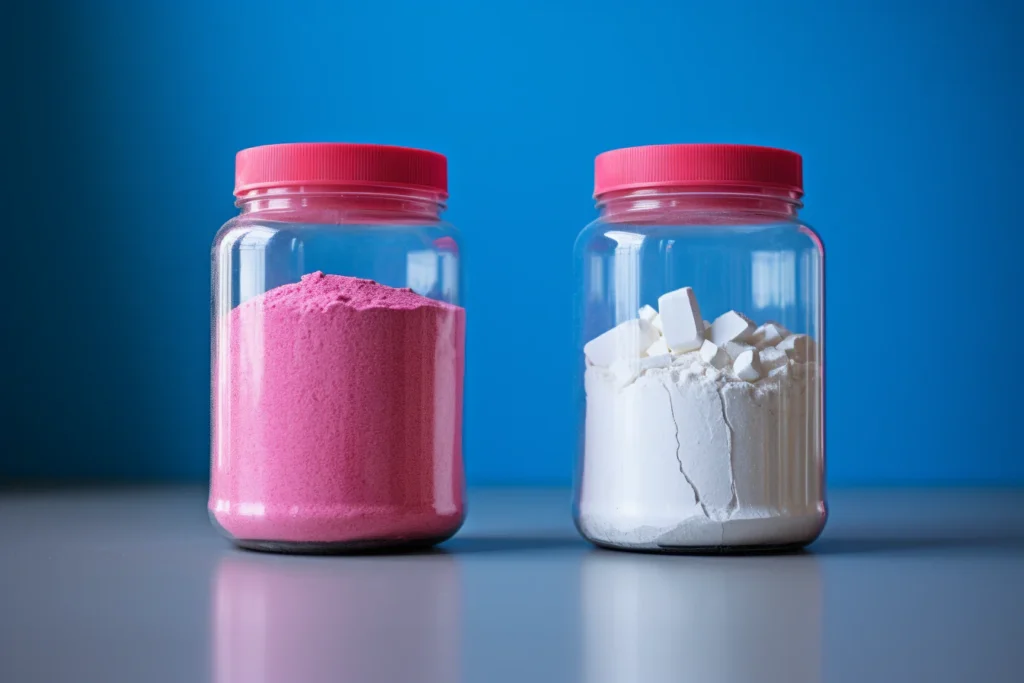In the world of sports supplements, creatine monohydrate is royalty. It is the most researched, effective, and trusted performance-enhancing supplement on the market, with a decades-long reign backed by an undisputed mountain of scientific evidence. But every king eventually faces a challenger. Enter Creatine Hydrochloride (HCL), a newer form marketed as a revolutionary successor.
The claims for Creatine HCL are bold and enticing: it’s vastly more soluble, better absorbed, and requires only a tiny “micro-dose” to deliver the same powerful results as monohydrate, all without the infamous “creatine bloat.”
This has left countless consumers at a crossroads, wondering if they should abandon the tried-and-true gold standard for the new, premium-priced alternative. Is HCL truly a technological leap forward, or is it a masterpiece of marketing built on a foundation of questionable science?
This evidence-based guide will put these two creatine forms head-to-head in a multi-round showdown. We will dissect the claims, examine the scientific evidence (and lack thereof), and deliver a clear verdict to help you make the smartest possible choice for your goals and your wallet.
The Quick Verdict: An Executive Summary
- The Gold Standard: Creatine monohydrate is supported by over 1,000 studies, proving its efficacy in increasing muscle mass, strength, and high-intensity exercise performance. Its oral bioavailability is already near-perfect (approximately 99%).
- The Challenger’s Claim: Creatine HCL is significantly more soluble in water. This is a demonstrable physical property that may reduce the chance of stomach discomfort for a very small percentage of users who are sensitive to monohydrate.
- The Critical Evidence Gap: There is a profound lack of scientific research on Creatine HCL, especially long-term human trials. Crucially, there is no robust scientific evidence to support the claim that a “micro-dose” of HCL is superior, or even equivalent, to a standard 3-5 gram dose of monohydrate for building muscle and strength.
- The Bottom Line: For over 99% of users, creatine monohydrate remains the vastly superior choice. Its effectiveness is unassailable, its safety profile is well-established, and its cost-effectiveness is unmatched. Creatine HCL is a significantly more expensive alternative whose marketed benefits are not supported by the current body of scientific literature.
The Contenders: Understanding the Chemical Makeup
- Creatine Monohydrate: The Undisputed Champion This is the classic, time-tested form. It consists of a single creatine molecule bonded to a single water molecule (a monohydrate). This simple, stable structure has been the subject of nearly all significant research on creatine’s benefits, from athletic performance to cognitive health. When you read about the proven benefits of creatine, you are reading about creatine monohydrate.
- Creatine HCL: The New Challenger Creatine HCL (Hydrochloride) is a creatine molecule bonded with a hydrochloride salt. This process was engineered to lower the pH and dramatically increase the molecule’s solubility in liquids. The entire premise for HCL’s existence is built on the theory that this superior solubility translates into superior real-world results.
Round 1: The Effectiveness Claim – Is a “Micro-Dose” of HCL Enough?
The cornerstone of HCL’s marketing is the idea of “micro-dosing.” Manufacturers suggest that a tiny dose of 750mg to 1.5g of HCL can deliver the same muscle-saturating effects as a standard 3-5g dose of monohydrate.
- The Marketing Argument: Superior absorption means less creatine is wasted and more reaches the muscles. Therefore, you need a much smaller dose.
- The Scientific Reality: This argument collapses under scrutiny for two key reasons. First, it’s based on a false premise: that monohydrate is poorly absorbed. In reality, multiple pharmacokinetic studies have established that the oral bioavailability of creatine monohydrate is excellent, approaching 99% when taken in standard doses. There isn’t much room for improvement.Second, and most importantly, the claims of HCL’s superior effectiveness at a micro-dose are not backed by peer-reviewed human studies on muscle growth.
- Case in Point: Direct Comparison Study: A pivotal study published in the Journal of the International Society of Sports Nutrition in 2015 directly compared the effects of HCL and monohydrate on strength in resistance-trained individuals. The study found no statistical differences in performance gains between the two groups. However, to achieve this parity, the researchers had to use equivalent doses (a standard 3-5 grams per day for both groups), not a micro-dose of HCL. This study directly refutes the idea that a smaller dose of HCL can match a standard dose of monohydrate.
Round 1 Winner: Creatine Monohydrate. Its effectiveness at a 3-5 gram dose is one of the most established facts in sports nutrition. The “micro-dosing” efficacy of HCL remains an unproven marketing claim.
Round 2: The Solubility Claim – Does Better Dissolving Mean Better Results?
This is the one area where HCL has a clear, demonstrable advantage. If you stir a scoop of each in a glass of water, the HCL will dissolve almost instantly and completely, while monohydrate may require more vigorous stirring and can leave some grit at the bottom. HCL is estimated to be about 38 times more soluble than monohydrate.
- The Marketing Argument: Better solubility equals better absorption, which equals better results.
- The Scientific Reality: While HCL is undeniably more soluble in a glass, this doesn’t automatically translate to a meaningful advantage inside the human body. The stomach is an extremely acidic environment (pH 1.5-3.5), which acts as a powerful solvent itself. It effectively dissolves the already highly bioavailable creatine monohydrate. Because your body already absorbs and utilizes nearly all the monohydrate you ingest, making it dissolve faster in water is a solution to a problem that doesn’t really exist.
Round 2 Winner: Creatine HCL (on the technical property of solubility), but this victory appears to have little to no practical significance for physiological outcomes like muscle saturation or performance.
Round 3: The Side Effects Claim – The End of Creatine Bloat?
Many potential creatine users are deterred by anecdotal reports of bloating and stomach discomfort from monohydrate. HCL is positioned as the bloat-free alternative.
- The Marketing Argument: HCL’s solubility prevents water from being drawn into the gut, eliminating bloating and the need to drink excessive amounts of water.
- The Scientific Reality: This claim is nuanced. For most users, the “creatine bloat” is either a myth or a temporary issue caused by improper usage. It’s often linked to:
- High-Dose Loading Phases: Consuming 20-25 grams daily for the first week can sometimes lead to temporary water retention as muscles become saturated.
- Insufficient Fluid Intake: Taking creatine powder without enough water can cause osmotic shifts in the gut, leading to discomfort.
Most users who skip the loading phase and take a standard 3-5 gram maintenance dose daily with a reasonable amount of fluid experience no digestive issues whatsoever. However, for a small percentage of individuals with genuinely sensitive stomachs, HCL may offer a benefit. Because it dissolves so readily, it is less likely to cause gastric distress for this specific, small subgroup.
Round 3 Winner: Creatine HCL (but only for a very small niche of users, as the problem it solves is largely avoidable with proper monohydrate usage).
Round 4: The Research Battle – Decades of Data vs. a Handful of Studies
This is the most lopsided round, and perhaps the most important for any discerning consumer.
- The Library of Evidence for Monohydrate: There are over 1,000 peer-reviewed scientific studies on creatine monohydrate listed on PubMed. Its effects on muscle hypertrophy, strength, power output, anaerobic performance, and even cognitive function have been rigorously documented for over three decades. Its safety profile is one of the most well-established in the entire supplement industry.
- The Scarcity of Research on HCL: In stark contrast, the body of evidence for Creatine HCL is minuscule. There are fewer than 10 relevant studies, and almost none are long-term trials focused on muscle growth and strength gains. Its long-term safety and efficacy are, from a scientific standpoint, largely unknown.
Round 4 Winner: Creatine Monohydrate. This isn’t just a win; it’s a testament to its status as the most reliable and trusted form of creatine.
Round 5: The Price Tag – Is HCL Worth the Extra Cost?
Value is a critical part of any purchasing decision. A quick search of the market reveals that on a per-serving basis, Creatine HCL is often 3 to 5 times more expensive than creatine monohydrate.
The marketing suggests this is offset by the smaller dose. But if a 1.5g dose of HCL is needed to (unprovenly) match a 5g dose of monohydrate, the cost per effective dose remains substantially higher. Given the lack of evidence for HCL’s superior efficacy, consumers are paying a significant premium for a benefit (solubility) that has little to no proven impact on results.
Round 5 Winner: Creatine Monohydrate. It is overwhelmingly more cost-effective.
The Final Verdict: A Decision Guide for YOU
While the marketing for Creatine HCL is compelling, the scientific evidence tells a clear and consistent story. There is a definitive winner for almost every consumer.
🏆 Choose CREATINE MONOHYDRATE If…
- You prioritize supplements whose effectiveness and safety are unquestionably proven by decades of robust scientific research.
- You want the best possible results for muscle growth and strength enhancement.
- You want the most cost-effective supplement to get the job done.
- You do not experience significant digestive issues when taking a standard 3-5 gram daily dose with a glass of water.
⚠️ Consider CREATINE HCL If…
- You are one of the very few individuals who has tried micronized creatine monohydrate with proper hydration and still consistently experiences significant stomach cramping or discomfort.
- Your budget is not a limiting factor, and you are willing to pay a substantial premium for the potential of reduced GI distress.
- You are comfortable using a product with a very limited scientific track record compared to the gold standard.
For Further Reading and Research
To explore the science and verify the claims made in this article, please consult these authoritative, evidence-based resources:
Examine.com – Creatine Page: An independent and unbiased organization that analyzes the full body of scientific literature on supplements. Their page on creatine is the most comprehensive resource available to the public.
https://examine.com/supplements/creatine/
Journal of the International Society of Sports Nutrition (JISSN): The premier peer-reviewed journal for sports nutrition science. Their position stands represent the scientific consensus on supplements.
JISSN Position Stand: Creatine Supplementation and Exercise
PubMed – National Library of Medicine: The primary database for all biomedical literature, where you can search for the original studies yourself.



